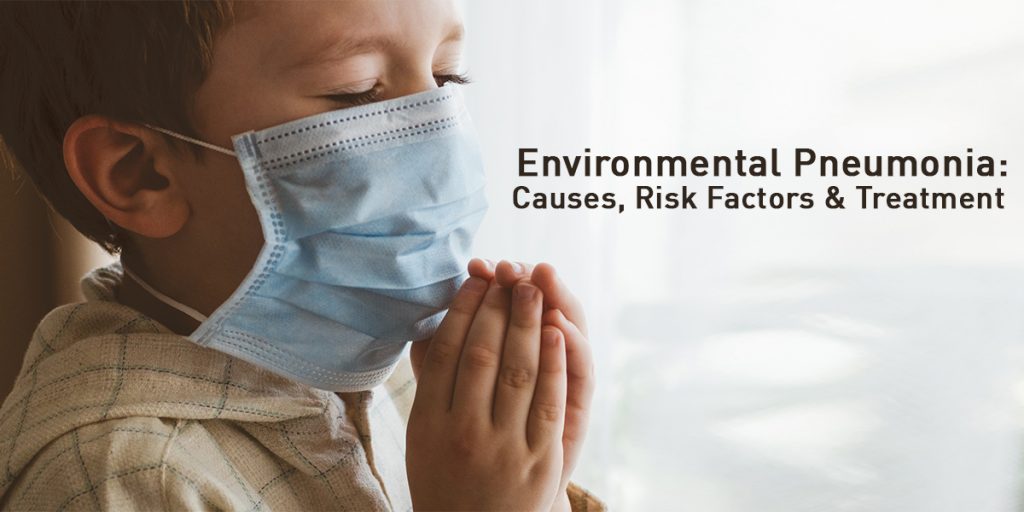Environmental Pneumonia: Symptoms, Causes and Treatment
A severe respiratory infection, Pneumonia directly affects the lungs. An individual suffering from pneumonia has pus and fluid-filled in the lung sacs, known as alveoli, limiting the oxygen intake. Mostly common among children, pneumonia is a matter of concern for every age group contributing to 15% of recorded deaths every year.
One of the major factors aggravating the cases of pneumonia is the increasing pollution levels. The following environmental factors are responsible for the growth of pneumonia, also known as environmental pneumonia:
- Indoor air pollution
- Staying in crowded locality and homes
- Second-hand smoking/passive smoking
With proper diagnosis and treatment, pneumonia is curable. Let’s find out some of the important facts about Pneumonia before we discuss the symptoms, causes and cure for environmental pneumonia
Important facts:
- Every year, Pneumonia kills 15% of children below the age of 5 years.
- It is caused by viruses, bacteria, or fungi.
- It can be prevented by strengthening the immune system, following a proper diet, and controlling pollution factors.
- Germs that can cause pneumonia are present in the environment itself.
- Lifestyle corrections and a clean environment may help reduce the risk of developing environmental pneumonia.
What are the symptoms of Environmental Pneumonia?
It is a contagious disease, which spreads from one infected person to another. At the onset, it develops by inhaling polluted air. Listed below are some of the symptoms for environmental pneumonia:
- Persistent cough
- Loss of breath
- Chest pain
- Fever
- Chills
- Fatigue
- Muscle pain
- Headache
What causes Environmental Pneumonia?
Malnutrition or undernourishment and air pollution are among the most prominent factors to cause environmental pneumonia. Other than the above mentioned causes.
Here are some more causes of environmental pneumonia:
- Pre-existing illness, such as HIV infections or measles
- Streptococcus pneumonia is the most common cause of bacterial pneumonia in children
- Haemophilus influenzae type B is the second most common cause of bacterial pneumonia
- The respiratory syncytial virus is the most common viral cause of pneumonia
- The viruses and bacteria found in a child’s nose or throat can infect the lungs if they are inhaled.
- The viruses and bacteria responsible for pneumonia may also spread via air-borne droplets from a cough or sneeze.
Is pneumonia contagious, environmental or genetic?
Respiratory infections are a result of the equation between genotype and the environment. Environmental factors like allergens, pollutants, smoke, and other irritants influence respiratory diseases. It is also noticed that certain genes do not have resistance against respiratory infections like asthma, COPD, and pneumonia.
How can you cure Environmental Pneumonia?
Some ways to cure environmental pneumonia include:
- Adequate rest: Resting will have the individual cure faster, and it will allow the body to focus on repair work, putting the muscles to rest.
- Keep the pollution factors low: A person suffering from pneumonia must be allowed to breathe clean and pure air. Allergens and pollutants present in polluted air influence pneumonia symptoms.
- Proper diet: Nutritious food is of utmost importance for the body to build immunity and fight off diseases.
- Medication: Medications may be prescribed to help reduce inflammation and improve lung function. These may include corticosteroids, immunosuppressants, and antibiotics if there is a secondary bacterial infection.
- Oxygen therapy: If oxygen levels in the blood are low, oxygen therapy may be necessary to help the patient breathe.
- Pulmonary rehabilitation: In some cases, pulmonary rehabilitation may be recommended to help improve lung function and breathing.
Natural Home Remedies For Pneumonia
Flowing homemade remedies to cures who is suffering from pneumonia and will help fight against the disease:
Peppermint, eucalyptus and fenugreek tea
Peppermint, eucalyptus, and fenugreek are warm herbs. According to a study, it was stated that peppermint and eucalyptus have a soothing effect on the throat of people with upper respiratory tract infections. These herbs break up mucus and ease the pain caused by pneumonia.
Black or green tea
Smaller portions of caffeine intake, such as a cup of coffee, green tea, or black tea can help to ease the loss of breath and such other symptoms in pneumonia. Caffeine opens the airway in the lungs, thus letting the person breathe properly.
Ginger or turmeric tea
Turmeric or ginger tea eases the chest pain caused by pneumonia. Drinking a warm tea made with ginger or turmeric root may reduce this pain. The roots of both have an anti-inflammatory effect in the body.
Fenugreek tea
For fever in pneumonia, fenugreek tea works effectively. As per a study, fenugreek tea promotes sweating, which in turn brings down the body temperature to normal.
“Prevention is better than cure”
With a proper diet and a healthy lifestyle, pneumonia can be kept at bay. Also, addressing environmental pollution, especially indoor air pollution can reduce the number of people falling ill with environmental pneumonia.
While you cannot do much about the outside air conditions but using an air purifier like KENT air purifier equipped with the latest technologies will keep the indoor air pollution levels under check. Equipped with HEPA air purification and ozone disinfection, KENT air purifiers remove bacteria, PM 2.5, and other pollutants from indoor air, ensuring clean, fresh, and healthy air. To know more visit air purifiers.





